Greece, Hellenistic Art (323-146 B.C.)
Philip II gave Macedonia hegemony over all of Greece and put the all the city-states under one constitution. After Philip II was assassinated in 323 B.C. at his daughter's wedding, his young son Alexander assumed the reigns of power at age twenty. Alexander
was raised on the Homeric epics; he wanted to be a hero on the Homeric model and to explore the world. It is doubtful that he entertained notions of world domination. The effect of his short rule was to combine
the cultures of the Greek states with those of Persia and the rest of Asia Minor. Hellenistic art is more personal, the figures represent real people rather than gods. In the hundred years after Alexander's
death, the Macedonians held Greece for a short time, then fights broke out for control among the Greek confederacies. In 229 B.C., the Romans gained a foothold in Illyria. By 146, the Romans had defeated their
final rivals in Greece-the Achaean Confederacy. The Romans destroyed the greatest commercial city: Corinth. From that point on, Greece was ruled by Rome and no longer independent.

Boetian, earthenware female figure, ca. 300 B.C.; 18 cm., British Museum, London, U.K. This statuette retains some of its reddish slip on the figure's hair.
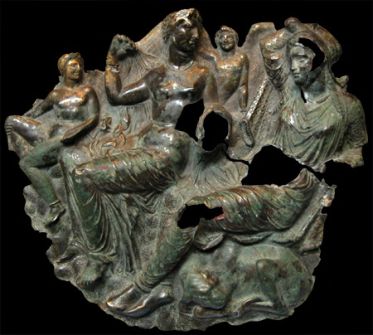
Mirror back; repoussé, copper alloy relief,; Greek, c. 320 BC; Aphrodite next to her suitor Anchises (shown in hunting ensemble with door by his feet) , with two Erotes. London, British Museum.
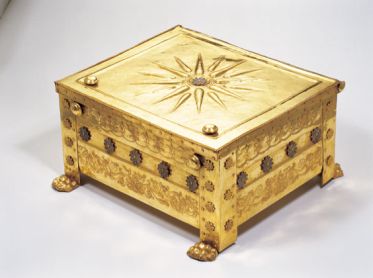
In 1977, when Vergina, the sacred site of the Macedonian royalty, was excavated, this coffin was found. At that time it was thought to contain the remains of Alexander the Great's father, Philip II of Macedonia, who ruled from 359 to 336 B.C.. The larynx is made of 24 karat gold with flowers surrounding the Macedonian royal star. The inside is blue enamel. Recently, archaeologists have disputed the claim that the remains are those of Philip II based primarily on the condition of the body, which suggests the deceased was not a soldier. Today many believe the larynx held the remains of his brother Philip III.
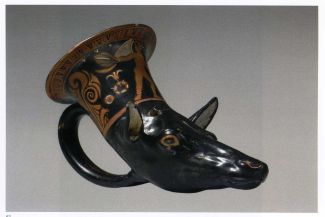
Rhyton in shape of a deer, a depiction of Eros above the face,
traditional egg-and-dot motif under lip; ca. 330-310 B.C.; 24.1 cm.

Statue of Woman, draped in blue chiton, with pink himation, handle
for leather strap on head; ca. 3rd century B.C.; 56 cm.

Eros, fragment of statuette, marble, Greek, ca. 2nd century B.C.; 16.4 x 9.8 x 9.8 cm., Museum of Fine Art, Boston, MA.
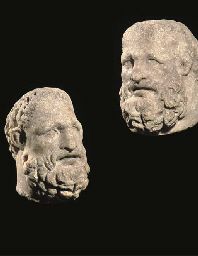
Marble head, possibly of Herakles or another fighter; ca. 2nd century B.C.;13.7 cm.

Aphrodite, head; marble; ca. 250 B.C., 13.7 cm.
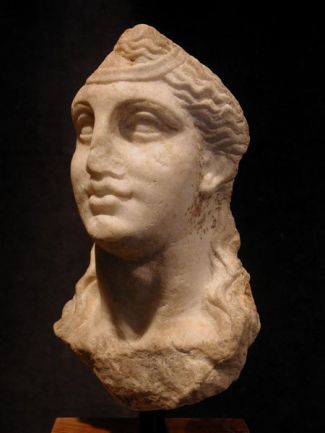
Dionysos, marble head fragment, Greek, ca. 2nd century B.C., 195 cm.

Herakles as an infant; bronze, ca. 1st century B.C.; inlaid teeth
and eyes, .622 m.; St. Louis Art Museum, St. Louis, MO.
|